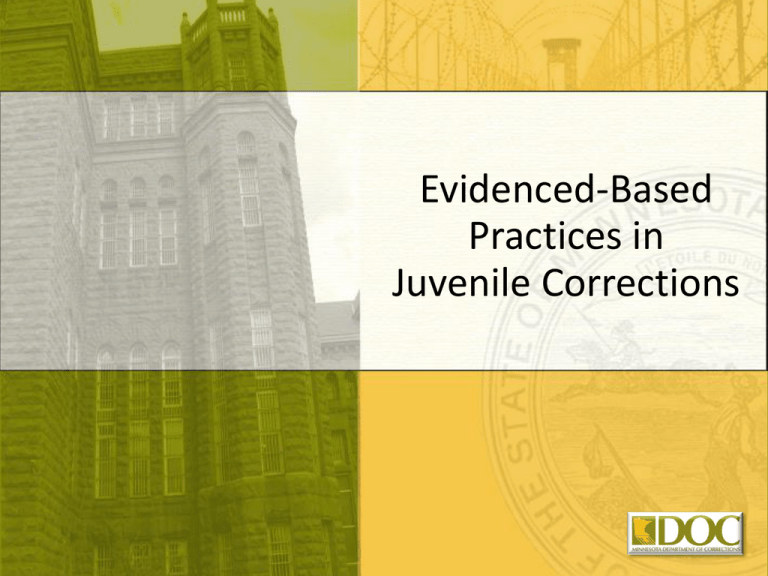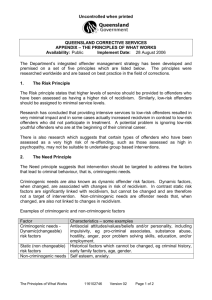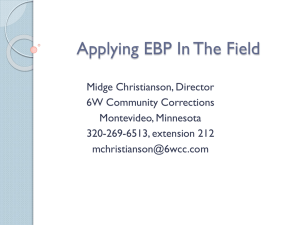Evidenced-Based Practice in Corrections
advertisement

Evidenced-Based Practices in Juvenile Corrections Clarifying Terms • Best Practices are often based on collective experience and wisdom of the field rather than scientifically tested knowledge • What Works implies linkage to general outcomes but does not specify the kind of outcomes desired • Evidenced-Based Practice implies definable outcomes, is measurable and is defined by practical realities 2 What Are Evidenced Based Practices (EBP)? EBP focuses on two main questions: What “works”? • Which types of programming, policies and practices have been effective in producing positive outcomes (recidivism, post-release employment, costbenefit)? For whom does it “work”? • Are there certain types of offenders for whom a certain type of program or practice is more or less effective? What Are Evidenced Based Practices? In corrections: Practices in which an agency systematically finds, appraises, and applies the most current and valid research findings as the basis for developing and implementing targeted interventions and programming proven to reduce recidivism. 4 Historical Perspective Rehabilitation 1960s What Works 2000 Politicization: Three Strikes 1990s Just Desserts Sentencing Guidelines 1970s Utilitarian: Mandatory Minimums 1980s 5 Research Foundation for Evidenced Based Practices In the 1980’s research began to appear supporting the notion that treatment works to reduce recidivism 30+ years of over 500 quality research studies Many sophisticated meta-analyses Canada, Europe, and United States 6 What Works Deliver services to higher-risk offenders Target criminogenic needs – those factors that can change over time Cognitive-behavioral interventions work best with appropriate offenders Treatment programs are matched to responsivity 7 What Does Not Work with Offenders Targeting low-risk offenders Deterrence alone without treatment Targeting non-criminogenic needs; i.e., anxiety, depression, self-esteem Scared straight approaches Insight oriented, psychodynamic, non-directive, or clientcentered therapies Lack of direct training procedures with an absence of modeling and role-playing 8 Essentials of EBP Measure Outcomes Engage Ongoing Support Increase Positive Reinforcement Cognitive Behavioral Interventions Target Intervention Enhance Intrinsic Motivation Assess Offender Risk/Needs 9 I. Assess Offender Risk/Needs Assess Offender Risk/Needs 10 I. Assess Offender Risk & Need Dynamic risk factors are linked to criminal behavior and can be changed • • • • • • Improved self-control Increased positive support networks Engagement in pro-social values Increased pro-social behaviors Substance abuse treatment Reconnection with primary/healthy relationships I. Assess Offender Risk & Need Static risk factors that do not predict criminal behavior • Age • Criminal or delinquent history • Offense I. Assess Offender Risks and Needs How do we identity Risk predictors? Youth Level-of-Service/Case Management Inventory (YLS/CMI) Juvenile Detention Risk Management Juvenile Sex offender assessments Chemical assessments 13 I. Assess Offender Risk & Need How do we identify these Need predictors? Massachusetts Youth Screening Inventory (MAYSI-2 for mental health) Problem Oriented Screening Instrument for Teenagers (POSIT) Substance Use Screenings Gambling Screen Personal Experience Screening Questionnaire (PESQ) I. Assess Offender Risks and Needs Actuarial risk to reoffend Identifies criminogenic needs 15 I. Risk Assessment Implementation Offenders under supervision are assessed to determine their likelihood to reoffend Determine level of supervision by setting cut off scores Drives the case plan Targets appropriate interventions 16 II. Enhance Intrinsic Motivation Enhance Intrinsic Motivation Assess Offender Risk/Need 17 II. Enhance Intrinsic Motivation “The only people who truly welcome change are wet babies” - Harvey Skinner 18 II. Enhance Intrinsic Motivation Motivational Interviewing Based on Prochaska’s stages of change: Establishes rapport Assesses readiness to change Centers on engagement and empowerment Utilizes the change process 19 II. Stages of Change 20 II. Enhance Offender Motivation For lasting change to occur, there needs to be a level of intrinsic motivation Research strongly suggest that motivational interviewing (MI) effectively enhances motivation for initiating and maintaining change behavior. III. Target Interventions Target Interventions Enhance Intrinsic Motivation Assess Offender Risk Need 22 III. Target Interventions Risk Need Responsivity 23 III. Target Interventions Risk Determine the risk to re-offend through use of validated, reliable “risk assessment” tools Work with moderate to high risk offenders; leave low risk offenders alone Use interventions that directly address offender characteristics associated with criminal behavior 24 III. Target Interventions Need Criminogenic needs can change over time Anti-social attitudes, anti-social associates, anti-social thinking patterns, anti-social behaviors i.e., substance abuse Criminogenic needs are identified through assessment tools and targeted through interventions 25 III. Target Interventions Responsivity Responsive to temperament, learning style, gender, culture when assigning programs Matching offender to the appropriate interventions given their risk level and crimnogenic needs 26 III. Target Interventions Relies on motivational interviewing Targets risk factors that lead to recidivism SMART case plan goals are: Small, measureable, attainable, realistic, timely Strength-based Gender, culturally, developmentally responsive Follows offender through the system 27 IV. Use Cognitive Behavioral Interventions Use Cognitive Behavioral Interventions Target Interventions Enhance Intrinsic Motivation Assess Offender Risk/Needs 28 IV. Use Cognitive Behavioral Interventions Treatment Principles: • Treatment, particularly cognitive-behavioral (CBT) is most effective with offenders • Proactive and strategic case planning • Targeted, timely treatment provides the greatest long term benefit • Applying treatment to lower risk offenders can have detrimental effects IV. Use Cognitive Behavioral Interventions Target criminal thinking Use cognitive-behavioral learning approaches • Modeling • Reinforcement • Role play • Coaching • Structured curricula Targeted treatment • Sex offender treatment • Chemical dependency treatment 30 V. Measure Outcomes Measure Outcomes Provide Ongoing Support Increase Positive Reinforcement Cognitive Behavioral Interventions Target Interventions Enhance Intrinsic Motivation Assess Offender Risk/Needs 31 V. Measurement Are there more effective ways to use taxpayer $ to achieve particular public outcomes Recidivism is the gold standard for better and for worse All the EBPs are shown to reduce recidivism 32 V. Measures are Tied to Mission Protect the public by: Providing for core correctional care Holding offenders accountable Changing offender behavior Restoring justice to victims 33 V. Examples of Corrections Outcome Measures Recidivism while under supervision Reduction in risk assessment score Restitution ordered and collected Recidivism three years post release 34 V. Types of Measurement Program Evaluation – Outcome Measures – Performance Measures Research using quasi or experimental design Cost Analysis – Cost Utility Analysis – Cost Effectiveness Analysis – Cost/Benefit Analysis 35 V. Cost/Benefit Analysis Evaluation of alternatives according to a comparison of both their costs and benefits when each is measured in monetary terms. Rigorous economic methodology using compounding and discounting Alternatives must show benefits in excess of costs Useful when benefits can be readily converted into monetary values 36 Keys to Successful Implementation of EBP’s Outside In Approach Adopting research-supported program models Minimizes “re-inventing the wheel” Must Implement with fidelity 37 Keys to Successful Implementation of EBP’s Inside Out Approach Develop and maintain internal information controls when implementing new practices Offender measures Operational measures Staff measures 38 Washington Institute of Public Policy www.wsipp.wa.gov 2006 Washington State faced need to construct several new prisons Legislature directed Institute to explore the use of evidenced-based options to reduce future need & crime rates Systematic review of 545 comparison group evaluations of adult, juvenile, prevention programs to reduce crime Estimated costs and benefits and developed portfolios 39 Evidenced Based Programs in Juvenile Cognitive-Behavioral Curricula Coordination of Services Functional Family Therapy Family Integrated Transitions Multi-Systemic Therapy Multidimensional Treatment Foster Care 40 Cognitive Behavioral Interventions Aggression Replacement Training (ART) An example of cognitive-behavioral curriculum 10 weeks, 30 hours Groups of 10 moderate to high risk youth 3 times/week Instructor and co-instructor/session 41 Cognitive Behavioral Interventions (ART) Improved attendance with transportation incentives and community locations Provided by probation officers or private contractors Anger control, life skills, moral reasoning Best used when all staff are trained Program Cost: $785/youth Benefits Minus Costs: $14,660 42 Coordination of Services (COS) 13 hours of educational classes Groups of 10 low risk juvenile offenders and parents Community outreach component to enable coordination Delivered by probation officers Program Cost: $229/youth $5493 Benefits minus Cost: 43 Functional Family Therapy (FFT) Structured home-based family intervention for high risk youth Trained FFT therapists with caseloads of 10 to 12 families 12 visits during a 12 week period FFT will reduce recidivism if properly implemented Program Cost: $2,609 Benefits Minus Costs: $33,632 44 Family Integrated Transitions (FIT) Structured home-based family intervention High-risk youth with the co-occurring mental illness and CD disorders Integrates Multi-Systemic Therapy, Motivational Enhancement Therapy, Relapse Prevention, and Dialectical Behavior Therapy Caseloads of 4 to 6 families for a 20 week period 45 Family Integrated Transitions (FIT) 24/7 availability by therapist FIT therapist participates on a team with clinicians, psychiatrist Program Cost: $9,938 Benefits Minus Costs: $36,117 46 Multi-Systemic Therapy (MST) Structured home-based family intervention for highrisk youth Trained MST therapists with caseload of 4 to 6 families for 16 week period 24/7 availability by therapist Therapist participates on team of clinicians Program Cost: $6,416 Benefits Minus Costs: $17,440 47 Multidimensional Treatment Foster Care (MTFC) Delinquents with chronic disruptive behavior Used as an alternative to placement Foster parents - highly trained, ongoing support, $43.70 savings for every dollar spend 48 Victim Offender Mediation (VOM) Both offender and the victim agree to a face-to-face meeting with a trained, neutral, mediator Purpose is to discuss the effects of the crime, and to determine what can be done to make amends to the victim and the community Program Cost: $880 Benefits Minus Costs: $7,067 49 Keys to Successful Implementation of EBP’s Cost shifting Fidelity Training, training, and re-training Organizational reinforcement 50 Presented by Deputy Commissioner Chris Bray, Ph.D., LP Community Services Division October 2010 51







